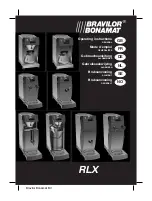
Section 7. Installation
intervals in the main program. When no measurements need to be spliced, the
slow-sequence scan will run independent of the main scan, so slow sequences
with no measurements can run at intervals
≤
main-scan interval (still in 10 ms
increments) without skipping scans. When measurements are spliced, checking
for skipped slow scans is done after the first splice is complete rather than
immediately after the interval comes true.
In sequential mode, all instructions in slow sequences are executed as they occur
in the program according to task priority.
Background calibration is an automatic, slow-sequence scan, as is the watchdog
task.
Read More
See the section
CR1000 Auto Calibration — Overview
(p. 92).
7.8.4.12.3 SubScan() / NextSubScan
SubScan()
/
NextSubScan
are used in the control of analog multiplexers (see the
appendix
Analog Multiplexers
(p. 646)
for information on available analog
multiplexers) or to measure analog inputs at a faster rate than the program scan.
SubScan()
/
NextSubScan
can be used in a
SlowSequenc / EndSequence
with
an interval of
0
.
SubScan
cannot be nested.
PulseCount
or SDM measurement
cannot be used within a sub scan.
7.8.4.12.4 Scan Priorities in Sequential Mode
Note
Measurement tasks have priority over other tasks such as processing and
communication to allow accurate timing needed within most measurement
instructions.
A priority scheme is used in sequential mode to avoid conflicting use of
measurement hardware. As illustrated in figure
Sequential-Mode Scan Priority
Flow Diagrams
(p. 158),
the main scan sequence has the highest priority. Other
sequences, such as slow sequences and calibration scans, must wait to access
measurement hardware until the main scan, including measurements and
processing, is complete.
Main Scans
Execution of the main scan usually occurs quickly, so the processor may be idle
much of the time. For example, a weather-measurement program may scan once
per second, but program execution may only occupy 250 ms, leaving 75% of
available scan time unused. The CR1000 can make efficient use of this interstitial-
scan time to optimize program execution and communication control. Unless
disabled, or crowded out by a too demanding schedule, self-calibration (see
CR1000 Auto Calibration — Overview
(p. 92))
has priority and uses some
interstitial scan time. If self-calibration is crowded out, a warning message is
issued by the CRBasic pre-compiler. Remaining priorities include slow-sequence
scans in the order they are programmed and digital triggers. Following is a brief
introduction to the rules and priorities that govern use of interstitial-scan time in
sequential mode. Rules and priorities governing pipeline mode are somewhat
more complex and are not expanded upon.
Permission to proceed with a measurement is granted by the measurement
156
Summary of Contents for CR1000
Page 2: ......
Page 4: ......
Page 6: ......
Page 32: ......
Page 36: ......
Page 38: ......
Page 40: ......
Page 60: ...Section 4 System Quickstart Figure 16 PC200W View Line Graph 60 ...
Page 96: ......
Page 98: ...98 ...
Page 302: ......
Page 453: ...Section 8 Operation Figure 115 Using the Keyboard Display 453 ...
Page 456: ...Section 8 Operation Figure 118 Real Time Custom 456 ...
Page 457: ...Section 8 Operation 8 8 1 3 Final Memory Tables Figure 119 Final Memory Tables 457 ...
Page 458: ...Section 8 Operation 8 8 2 Run Stop Program Figure 120 Run Stop Program 458 ...
Page 460: ...Section 8 Operation Figure 122 File Edit 460 ...
Page 461: ...Section 8 Operation 8 8 4 PCCard Memory Card Display Figure 123 PCCard CF Card Display 461 ...
Page 478: ......
Page 506: ......
Page 536: ......
Page 636: ......
Page 642: ......
Page 644: ......
Page 676: ......
Page 677: ......
















































